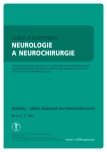The Importance and Limits of the Pressure Ulcer Surgical Debridement
Authors:
J. Stryja
Authors place of work:
Vzdělávací a výzkumný institut AGEL, Salvatella s. r. o., Třinec
Published in the journal:
Cesk Slov Neurol N 2016; 79/112(Supplementum1): 25-27
Category:
Původní práce
doi:
https://doi.org/10.14735/amcsnn2016S25
Summary
Pressure ulcers are skin and soft tissue lesions appearing in over-pressured places of the body. According to EPUAP/ NPUAP classification, the presence of necrosis is a basic condition for determining the third and fourth stage of pressure ulcers. Necrotic tissue on the wound impedes the healing process and granulation tissue formation and is a source of infection and malodour. It poses a serious wound bioburden. Removal of the necrosis (necrectomy) and pressure ulcer bed debridement are important steps in a wound bed preparation (TIME concept). In practice, presence of moist necrosis (slough) is often being connected with presence of a wound infection, whereas dry gangrene (eschar) obstructs wound healing far less, and non-infected eschar can in some cases serve as a temporary pressure ulcer covering. Proper timing of debridement together with selectionof a correct debridement method noticeably affects treatment results. Despite of the well-known advantages, debridement can sometimes disrupt the healing process: over-excision leads to removal of the necrosis and even of the vital tissue close to the necrosis; debridement methods causing wound trauma (scissors, electrocautery) remove deficient tissues as well as they disrupt the wound bed vitality. Our research consisted of two parts: experimental (on a tissue model) and clinical part (on a group of probands). We have shown that sharp (scalpel) and hydrosurgical debridement (Vestajet) speed up the debridement process and shorten the total time for tissue recovery.
Key words:
debridement – pressure ulcer – necrectomy
The authors declare they have no potential conflicts of interest concerning drugs, products, or services used in the study.
The Editorial Board declares that the manuscript met the ICMJE “uniform requirements” for biomedical papers.
Zdroje
1. Haesler E, ed. National Pressure Ulcer Advisory Panel, European Pressure Ulcer Advisory Panel and Pan Pacific Pressure Injury Alliance. Prevention and Treatment of Pressure Ulcers: Quick Reference Guide. Perth, Australia: Cambridge Media 2014.
2. Kingsley A. A proactive approach to wound infection. Nurs Stand 2001;15(30):50 – 8.
3. Sibbald RG, Williamson D, Orsted HL, et al. Preparing the wound bed: debridement, bacterial balance, and moisture balance. Ostomy Wound Manager 2000;46(11):14 – 22,24 – 8,30 – 5.
4. Rogers AA, Burnett S, Moore JC, et al. Involvement of proteolytic enzymes, plasminogen activators, and matrix metalloproteinase levels in pathology of pressure ulcers. Wound Repair Regen 1995;3(3):273 – 83.
5. Baranoski S, Ayello E. Wound care essentials: practice principles. 2nd ed. Philadelphia: Lippincott Williams & Wilkins 2008 : 120.
6. Strohal R, Apelqvist J, Dissemond J, et al. An updated overview and clarification of the principle role of debridement. J Wound Care 2013;22(Suppl 1):S1 – 52.
7. Stryja J. Débridement a jeho úloha v managementu rány. 1. vyd. Semily: Nakladatelství Geum 2015 : 173.
8. Wound Ostomy and Continence Nurses Society. Guideline for prevention and management of pressure ulcers. [online]. Available from URL: http:/ / guideline.gov/ content.aspx?id=23868.
9. Pokorná A, Leaper D. Assessment and documentation of non-healing, chronic wounds in inpatient health care facilities in the Czech Republic: an evaluation study. Int Wound J 2015;12(2):224 – 31. doi: 10.1111/ iwj.12372.
Štítky
Dětská neurologie Neurochirurgie NeurologieČlánek vyšel v časopise
Česká a slovenská neurologie a neurochirurgie

2016 Číslo Supplementum1
Nejčtenější v tomto čísle
- Sorrorigenní rány, jejich identifikace a průběh péče
- Inkontinenční dermatitida – současné poznatky o etiologii, diagnóze a prevenci
- Význam a možnosti chirurgického débridementu dekubitů
- Význam tlakové mapy (pressure mapping system) pro pacienty s mobilitou na vozíku
